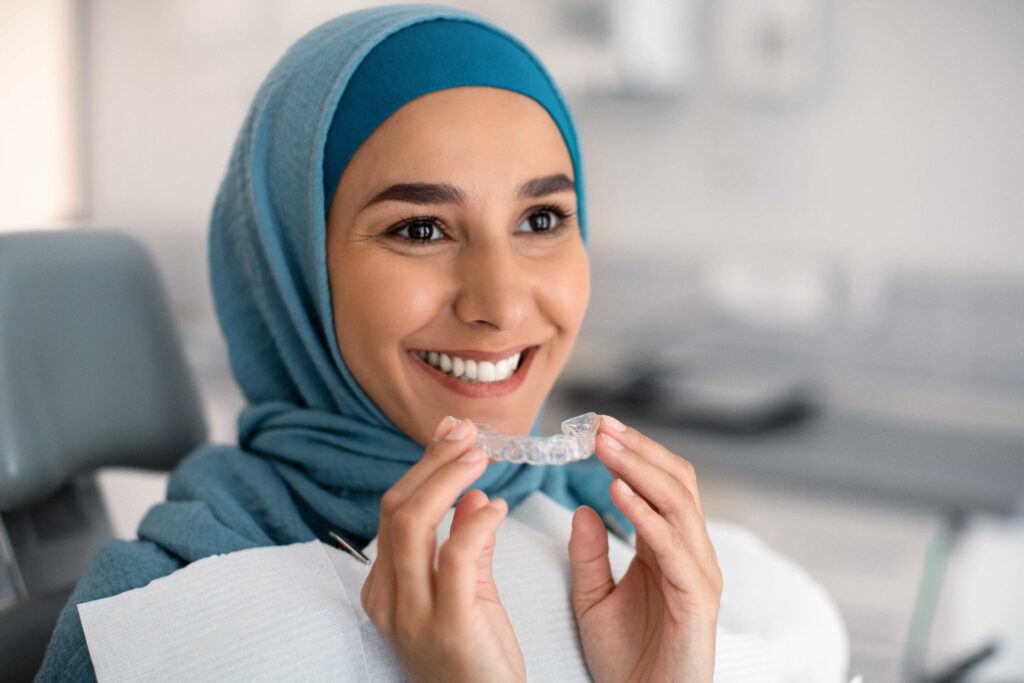Invisalign vs. Braces: Choosing the Right Orthodontic Solution
Orthodontic treatment is a crucial step towards achieving a confident smile and maintaining optimal oral health. With advancements in orthodontics, individuals now have the opportunity to choose between traditional braces and Invisalign, a revolutionary clear aligner system. This blog post is designed to provide an in-depth comparison of these two orthodontic solutions, helping you make an informed decision for your orthodontic journey.
Understanding Orthodontic Treatment Options
Orthodontic treatment involves the use of dental appliances to correct misaligned teeth and jaws, enhancing both aesthetics and functionality. Two popular options in this realm are traditional braces and Invisalign. Both approaches aim to align teeth, but they differ in their mechanisms and benefits.

Invisalign
The Clear Aligner System Invisalign is a modern orthodontic solution that employs a series of custom-made, clear aligners to gradually shift teeth into their desired positions. The advantages of Invisalign include:
Aesthetic Appeal
Invisalign aligners are virtually invisible, addressing the aesthetic concerns often associated with metal braces. This makes them particularly attractive to individuals who are conscious about their appearance during treatment.
Removable Nature
One of Invisalign’s standout features is its removability. This means you can easily remove the aligners when eating, drinking, brushing, and flossing. This not only maintains oral hygiene but also allows you to enjoy your favorite foods without constraints.
Comfort
Invisalign aligners are smooth and free from sharp brackets and wires. This results in a more comfortable experience, with reduced chances of irritation or mouth sores.
However, it’s important to acknowledge that Invisalign has its limitations. It may not be suitable for complex orthodontic cases that require more extensive movements. Additionally, the success of Invisalign treatment relies on your commitment to wearing the aligners for the recommended 20-22 hours per day.
Braces
Traditional Orthodontic Solution Traditional braces have been a trusted orthodontic solution for many years. They consist of metal brackets bonded to the teeth and connected by archwires. The benefits of braces include:
Effectiveness
Braces are highly effective in addressing a wide range of orthodontic issues, including severe misalignments and bite problems. Their fixed nature ensures consistent force application.
Consistent Treatment
Unlike removable aligners, braces are fixed onto the teeth throughout the treatment period. This means that they work 24/7, ensuring continuous progress without relying on patient compliance.
Cost-Effectiveness
Braces are often considered more cost-effective than certain alternatives, making them accessible to a broader range of patients.
However, traditional braces also come with considerations. The visible presence of metal brackets and wires may impact aesthetics, and patients must adhere to strict dietary guidelines to prevent damage to the hardware. Additionally, oral hygiene routines may require a bit more attention to maintain optimal dental health.
Factors to Consider When Choosing Selecting the right orthodontic solution involves weighing various factors
Orthodontic Needs
The complexity of your case is a significant determinant. Invisalign is excellent for mild to moderate cases, while braces can effectively handle more intricate situations.
Aesthetic Preferences
If the appearance of your orthodontic appliance is a primary concern, Invisalign’s clear aligners may align with your preferences.
Lifestyle and Commitment
Invisalign offers the convenience of removability, but success depends on consistent wear. Braces require less patient involvement but don’t offer the same level of flexibility.
Treatment Duration and Frequency
Invisalign treatment may require fewer visits to the orthodontist, while braces often necessitate more frequent adjustments and check-ups.
Budget Considerations
The cost of treatment varies. Consultation with an orthodontist will help you understand the financial aspects and explore payment options.
Consultation and Customized Treatment Plan
The cornerstone of any successful orthodontic journey is a personalized treatment plan. Consult an experienced orthodontist who will assess your dental health, bite alignment, and overall goals. They will employ tools like X-rays, photographs, and digital impressions to create a tailored treatment strategy.
Maintenance and Aftercare Proper maintenance is crucial for the success of your orthodontic treatment.
For Invisalign
Cleaning Aligners
Remove aligners before eating or drinking anything other than water. Clean them gently with lukewarm water and a soft toothbrush to prevent discoloration and odors.
Wearing Instructions
Commit to wearing each set of aligners for the recommended 20-22 hours per day for optimal results.
For braces
Oral Hygiene
Maintain diligent oral hygiene practices to prevent plaque buildup around brackets and wires. Use specialized tools such as interdental brushes and floss threaders for thorough cleaning.
Dietary Considerations
Avoid hard, sticky, and sugary foods that can damage braces and increase the risk of cavities.
Making Your Decision
The decision between Invisalign and braces is highly individualized. It’s a collaboration between you and your orthodontist. By considering your specific needs, preferences, lifestyle, and budget, you’ll be able to make an informed choice that aligns with your goals.
Table of Contents
Recent post

Dental Makeovers: Transforming Your Smile with Cosmetic Dentistry


Restoring Dental Function: Restorative Treatments for Long-Lasting Smiles
Invisalign vs. Braces FAQs
Which option is more discreet?
Invisalign is generally considered more discreet due to its clear aligners. Braces, on the other hand, have visible metal brackets and wires.
Is one option more effective than the other?
Both Invisalign and braces are effective in straightening teeth. The choice depends on the complexity of your case and your orthodontist’s recommendation.
Can I remove Invisalign aligners for special occasions?
While you can remove Invisalign aligners, it’s recommended to wear them as instructed to ensure treatment progresses effectively.
Are braces uncomfortable to wear?
Discomfort is common when braces are first placed and after adjustments. Over-the-counter pain relievers and orthodontic wax can help alleviate discomfort.
How often do I need to visit the orthodontist with each option?
Invisalign generally requires fewer visits, usually every 6-8 weeks. Braces may require more frequent visits for adjustments, typically every 4-6 weeks.
Will my dental insurance cover either option?
Many dental insurance plans provide coverage for orthodontic treatment, but the extent of coverage varies. It’s advisable to contact your insurance provider for details.
Conclusion
The choice between Invisalign and braces is a significant one, influencing your appearance, comfort, and overall orthodontic experience. Consulting an orthodontist is paramount to receiving expert guidance tailored to your needs. By understanding the advantages and considerations of both options, you’re well-equipped to embark on your journey towards a healthier, more confident smile.
